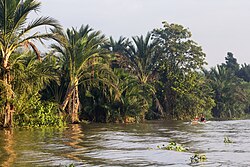| Martapura River Sungai Banjar Kecil, Sungai Kayutangi Sungai Cina, Sungai Tatas, Soengai Martapoera | |
|---|---|
 Martapura River outside Banjarmasin | |
 | |
| Native name | Sungai Martapura (Indonesian) |
| Location | |
| Country | Indonesia |
| Province | South Kalimantan |
| Physical characteristics | |
| Source | |
| • location | Martapura, Banjar Regency |
| Mouth | Barito River |
The Martapura River (Indonesian : Sungai Martapura) is a river in southeast Borneo, Indonesia. [1] [2] It is a tributary of the Barito River. Other names for the river are Banjar Kecil River [3] [4] [5] [6] or Kayutangi River and due to many activities of Chinese merchants in the past in the downstream area also called China River. [7] [8] [9] It merges with the Barito River in Banjarmasin, flowing from the source in Martapura, Banjar Regency, South Kalimantan. [10]






